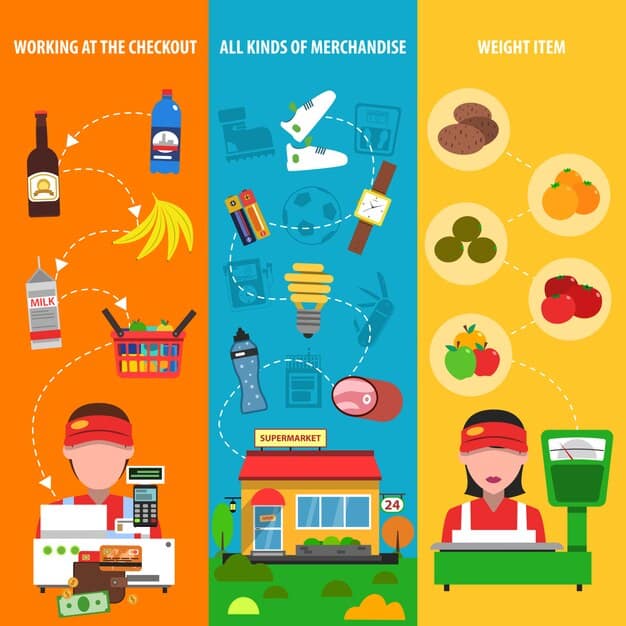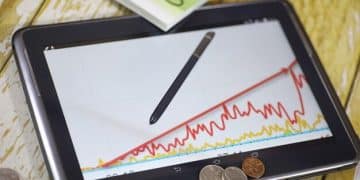Consumer Spending Habits: Retail Sales & Economic Insights

Analyzing retail sales figures unpacks consumer spending habits, offering a vital snapshot of economic health, indicating trends in consumer confidence, purchasing power, and potential future economic trajectories.
Understanding consumer spending habits: what do the latest retail sales figures tell us about the economy? This is a question policymakers, businesses, and everyday citizens frequently ask to gauge the economic pulse. Retail sales data provides a critical window into the financial choices households make, offering invaluable insights into current economic growth, inflationary pressures, and consumer confidence.
Understanding the Landscape of Retail Sales Data
Retail sales figures are more than just numbers; they are a direct reflection of household economic activity. Their importance cannot be overstated, as they directly contribute to the Gross Domestic Product (GDP), a primary measure of a nation’s economic output. When consumers spend, businesses thrive, jobs are created, and the overall economy gains momentum. Conversely, a slowdown in retail sales can signal economic contractions or a dip in consumer confidence, prompting concerns about recessionary pressures. Analyzing these figures involves looking beyond the headline numbers to understand underlying trends, seasonal adjustments, and sector-specific performances.
The U.S. Census Bureau compiles and releases monthly retail sales data, providing a comprehensive overview of sales at stores and online. This data is seasonally adjusted to account for predictable fluctuations, such as holiday shopping rushes, ensuring that analysts can identify true underlying trends rather than calendar-driven anomalies. Different sectors, from auto dealers to food services and general merchandise stores, are tracked, allowing for a granular understanding of where consumer dollars are being allocated across the economy.
Key Components of Retail Sales Data
When diving into the latest retail sales figures, it’s crucial to disaggregate the data to gain a nuanced understanding. The aggregate numbers can sometimes mask significant variances between different retail categories. For instance, a surge in online sales might offset a decline in brick-and-mortar store purchases, leading to a flat overall figure that doesn’t tell the whole story. Understanding specific categories helps identify shifts in consumer preferences and economic priorities.
- Motor Vehicle and Parts Dealers: Often a significant driver due to the high cost of vehicles. Fluctuations here can indicate major shifts in consumer confidence and access to credit.
- Food Services and Drinking Places: Reflect discretionary spending on experiences, indicating how comfortable consumers feel spending on non-essentials.
- Nonstore Retailers (Online Sales): Continues to grow, showcasing the ongoing shift towards e-commerce and its impact on traditional retail.
- General Merchandise Stores: A broad category including department stores, providing insights into general consumer purchasing behavior.
Dissecting these categories provides a clearer picture of consumer behavior. Are people prioritizing necessities over luxuries? Are they embracing online shopping more than ever? These detailed insights help economists and businesses make more informed decisions. Moreover, looking at month-over-month and year-over-year changes provides crucial context, helping distinguish short-term volatility from long-term trends.
Understanding the nuances of these figures allows for a more accurate interpretation of the economic landscape. It’s not just about how much is spent, but where and why. This level of detail is essential for painting a complete picture of consumer spending habits and their broader economic implications.
Recent Trends in Consumer Spending: A Deeper Dive
The past year has presented a complex picture of consumer spending, marked by resilience in some sectors and noticeable shifts in others. Despite persistent inflationary pressures and rising interest rates, consumer spending has largely held up, albeit with some moderation. The latest figures often show consumers continuing to prioritize essential goods and services, while discretionary spending becomes more selective. However, the exact patterns of expenditure vary widely by income level and demographic, highlighting the uneven impact of economic conditions.
One notable trend is the sustained strength of spending on services, such as travel, entertainment, and dining out, as consumers continue to prioritize experiences over physical goods. This shift reflects a post-pandemic rebalancing, where pent-up demand for social activities drives spending in these areas. Conversely, spending on certain durable goods, which saw a boom during the early pandemic period as people invested in their homes, has started to normalize or even decline. This normalization indicates saturation in some markets and a pivot in consumer priorities.

Impact of Inflation and Interest Rates
Inflation has undeniably reshaped consumer spending. While nominal retail sales might appear strong, much of this increase can be attributed to higher prices rather than increased consumption volume. Consumers are paying more for the same goods, which can erode purchasing power and lead to tough choices about what to buy. High inflation pushes households to reallocate budgets, often cutting back on non-essential items to cover the rising costs of food, fuel, and housing. This inflationary environment particularly impacts lower-income households, who spend a larger proportion of their income on necessities.
Rising interest rates, a tool used by central banks to combat inflation, also play a significant role. Higher rates increase the cost of borrowing for major purchases like cars and homes, and also affect credit card debt. This can lead consumers to delay or forgo large purchases, impacting sectors dependent on consumer credit. The balance between combating inflation and supporting consumer spending is a delicate act for economic policymakers. The pressure on household budgets from both inflation and higher borrowing costs influences the overall trajectory of consumer spending and, by extension, the broader economy.
The interplay of these factors creates a dynamic and sometimes unpredictable spending environment. While some consumers show astonishing resilience, others face significant financial strain, leading to a divergence in spending patterns across different segments of the population. This necessitates a careful, disaggregated analysis of data to truly understand the underlying economic currents.
The Amazon Effect and E-commerce Dominance
The rise of e-commerce, spearheaded by giants like Amazon, has fundamentally reshaped the retail landscape. What was once a supplementary channel has become a primary shopping destination for many consumers, influencing everything from product availability to delivery expectations. This “Amazon Effect” refers to the pervasive influence of online retail on traditional brick-and-mortar stores, compelling them to adapt or risk obsolescence. The latest retail sales figures consistently highlight the outsized growth of nonstore retailers, underscoring the enduring power of digital shopping.
The convenience of online shopping, coupled with competitive pricing and vast product selections, continues to attract consumers. E-commerce platforms offer a seamless experience that often surpasses traditional retail in terms of accessibility and variety. This trend has accelerated significantly since the pandemic, as consumers became accustomed to the ease of doorstep delivery for a wide array of goods. The implications for the economy are vast, affecting everything from supply chains and logistics to the viability of physical retail spaces and employment patterns.
Digital Transformation of Retail
Beyond simply shifting sales online, the dominance of e-commerce has spurred a profound digital transformation across the entire retail sector. Traditional retailers are investing heavily in their online presence, developing robust e-commerce platforms, enhancing their omnichannel strategies (integrating online and in-store experiences), and leveraging data analytics to better understand consumer behavior. This modernization is a necessity for survival in a highly competitive market where consumer expectations are largely set by industry leaders like Amazon.
- Omnichannel Integration: Seamless shopping experiences across online, mobile, and physical stores. This includes “buy online, pick up in-store” (BOPIS) options.
- Personalization through Data: Using consumer data to offer tailored product recommendations and promotions, enhancing the shopping experience.
- Logistics and Fulfillment Optimization: Investing in faster delivery methods and efficient supply chains to meet consumer demands for quick gratification.
- Emphasis on Customer Experience: Beyond just transactions, retailers focus on loyalty programs, easy returns, and responsive customer service to retain buyers.
The digital revolution in retail has also led to innovations in payment methods, augmented reality shopping, and more sophisticated digital marketing. These advancements collectively contribute to a dynamic retail environment where agility and technological adoption are key determinants of success. The continuous evolution of digital retail means consumer spending habits are likely to become even more intertwined with technological convenience and innovation in the years to come, further solidifying the role of e-commerce as a dominant force in the economy.
Discretionary vs. Essential Spending: What’s the Shift?
The distinction between discretionary and essential spending offers crucial insights into how consumers are navigating economic conditions. Essential spending covers necessities such as groceries, utilities, housing, and basic transportation. Discretionary spending, on the other hand, includes non-essential items and experiences like dining out, entertainment, luxury goods, new apparel beyond necessity, and vacations. Analyzing shifts between these two categories reveals a great deal about consumer confidence, disposable income levels, and overall economic stability.
In times of economic uncertainty or high inflation, consumers typically prioritize essential spending, often cutting back significantly on discretionary purchases. This trend is a natural response to tighter budgets, as households focus on meeting fundamental needs. Recent retail sales figures often show resilience in essential categories, even as some discretionary sectors face headwinds. However, this isn’t always a straightforward division; for example, what constitutes ‘essential’ can vary by income bracket and lifestyle. Yet, the broad patterns provide valuable signals.

Signals of Economic Health and Consumer Confidence
A robust increase in discretionary spending is generally viewed as a positive sign for the economy, indicating strong consumer confidence and healthy disposable incomes. When people feel secure about their financial future, they are more willing to spend on non-necessities, fueling growth in sectors like tourism, hospitality, and luxury retail. Conversely, a prolonged decline in discretionary spending can signal underlying economic concerns, such as fear of job loss, stagnant wages, or anxieties about future economic downturns. This shift can precede broader economic slowdowns, making it a critical indicator for economists and policymakers.
Economists closely monitor the ratio of discretionary to essential spending for early warnings. For instance, if food and energy prices spike, consumers may have less money left over for a new outfit or a night out. This “crowding out” effect can quickly ripple through the economy. Similarly, a noticeable pullback in big-ticket discretionary items, like furniture or major appliances, often indicates a broader concern about future economic stability. Understanding these shifts allows for more accurate forecasting of economic performance and helps businesses adapt their strategies to evolving consumer priorities. It reinforces the idea that consumer behavior is an economic barometer, reflecting underlying sentiment and economic realities.
Supply Chain Dynamics and Product Availability
The intricate web of global supply chains plays a critical role in shaping consumer spending habits by influencing product availability and pricing. Disruptions, whether from geopolitical events, natural disasters, or public health crises, can lead to shortages, delivery delays, and elevated costs, directly impacting what consumers can buy and at what price. The recent years have vividly illustrated how vulnerable supply chains can be, leading to periods where demand outweighed supply in various sectors, from electronics to automobiles.
When products are scarce, consumers may either defer purchases, seek alternatives, or pay higher prices, depending on the urgency and substitutability of the item. This dynamic can distort retail sales figures, as a dip in sales might reflect a lack of available products rather than diminished consumer demand. Conversely, an easing of supply chain pressures can lead to a surge in sales as backlogged demand is met, or even a decrease in prices, potentially boosting overall consumer spending power. The efficiency and resilience of supply chains are therefore paramount to maintaining stable consumer spending patterns and overall economic health.
How Supply Chain Issues Influence Consumer Choices
Supply chain impediments have forced consumers to adapt their buying behaviors in several ways. The predictability of having products readily available has been challenged, prompting shifts in purchasing strategies.
- Brand Loyalty Erosion: When preferred brands are unavailable, consumers are more likely to try alternatives, potentially leading to lasting changes in brand preferences.
- Increased Pre-ordering/Planning: For highly anticipated or commonly scarce items, consumers may pre-order months in advance or plan purchases with longer lead times.
- Tolerance for Delays: A widespread understanding of global logistics challenges has made some consumers more tolerant of extended delivery times, though convenience remains a priority.
- Local Sourcing: Some consumers and businesses have started to favor locally sourced products where supply chains are shorter and less prone to global disruptions.
These adjustments in consumer behavior, driven by supply chain realities, ripple through the retail sector. Retailers, in turn, are forced to adapt their inventory management, diversify their supplier base, and invest in more robust logistics solutions. The ongoing efforts to build more resilient supply chains are not just about business continuity; they are about ensuring that consumer demand can be met efficiently, directly supporting the stability and growth of retail sales and the broader economy. The interplay between global production, transportation, and consumer purchasing decisions is a complex dance, constantly being choreographed by evolving supply chain dynamics.
The Role of Savings and Debt in Spending Decisions
Consumer spending is not solely determined by income but also significantly influenced by the levels of personal savings and household debt. When savings are high, consumers generally feel more financially secure and are more inclined to spend, especially on discretionary items. Conversely, a reduction in savings or an increase in debt can lead to more cautious spending habits, as households prioritize debt repayment and building emergency funds. The interplay of these two factors provides critical insight into the underlying financial health and confidence of consumers.
In recent periods, consumers have faced a dual challenge: higher costs of living due to inflation coupled with rising interest rates on debt. This environment can rapidly erode savings and make new borrowing more expensive, potentially curbing spending. Personal savings rates, which surged during the initial phases of the pandemic, have largely returned to pre-pandemic levels or even declined, indicating that many households are drawing down on their reserves to maintain their current consumption levels. This trend suggests that continued spending might be unsustainable without corresponding income growth or a decrease in expenses.
Household Debt: A Growing Concern?
While savings have fallen, household debt has been on an upward trajectory, particularly in categories like credit card debt. This increase in leverage, especially at higher interest rates, means a larger portion of household income is being allocated to debt servicing rather than new consumption or savings. Higher credit card balances can act as a drag on future spending, as consumers become more constrained by their existing financial obligations. Analyzing the types of debt—mortgage, auto loans, student loans, and credit card debt—provides a deeper understanding of where financial pressure points lie for consumers.
- Credit Card Debt: Often the most concerning due to high interest rates, impacting discretionary spending capacity. A rise can signal financial stress.
- Auto Loans: Significant increases can reflect higher vehicle prices and longer loan terms, potentially straining monthly budgets.
- Student Loan Payments: Resumption of payments or rising balances can reduce disposable income for a significant portion of the population.
- Mortgage Debt: While often considered “good debt,” rising interest rates affect new borrowers and those refinancing, impacting housing affordability and overall spending.
The delicate balance between savings and debt is a strong predictor of future consumer behavior. While a healthy amount of debt can stimulate economic activity (e.g., mortgages for homeownership), excessive or high-cost debt can stifle it by limiting household flexibility. Governments and financial institutions closely monitor these trends, as they directly impact economic stability and the potential for sustainable growth in consumer spending. Understanding this balance is essential for interpreting retail sales figures beyond face value, offering a more holistic view of economic resilience.
Future Outlook for Consumer Spending
Projecting the future of consumer spending involves navigating a complex interplay of economic indicators, policy decisions, and global events. While recent data suggests a degree of resilience, the sustainability of current spending patterns is a subject of ongoing debate among economists. Factors such as persistent inflation, the trajectory of interest rates, the labor market’s strength, and geopolitical stability will all play pivotal roles in shaping how consumers choose to allocate their resources in the coming months and years. Forecasting consumer spending is not an exact science, but rather a careful assessment of probabilities and potential risks.
One key element to consider is the continued strength of the job market. Low unemployment rates and wage growth can provide a crucial buffer against inflationary pressures, ensuring that consumers have the income to support current spending levels. However, if job growth falters or wages fail to keep pace with inflation, consumer purchasing power could diminish significantly. Similarly, the effectiveness of monetary policy in taming inflation without triggering a sharp economic downturn will directly impact consumer confidence and spending intentions. A “soft landing” scenario, where inflation cools without a recession, would be the most favorable outcome for sustained consumer spending.
Potential Headwinds and Tailwinds
Several forces could either bolster or hinder consumer spending in the near future. On the positive side, innovation in products and services, particularly in areas like artificial intelligence and green technologies, could stimulate new avenues for spending. A potential easing of supply chain disruptions could also lead to lower prices and increased product availability, encouraging consumption. Furthermore, fiscal policies that support consumer direct aid or tax relief could provide a much-needed boost to household budgets.
However, significant headwinds remain. The ongoing geopolitical instability, particularly conflicts that impact energy and commodity prices, could reignite inflationary pressures. A prolonged period of high interest rates could further dampen major purchases and increase debt burdens. Moreover, the long-term effects of depleted savings and increased reliance on credit could eventually catch up, leading to a more conservative spending approach by households. Predicting these outcomes requires constant monitoring of a wide array of economic data and an understanding of how interconnected global markets truly are.
Ultimately, the future of consumer spending will likely be characterized by adaptability and selectivity. Consumers will continue to make trade-offs, prioritizing value, convenience, and experiences over indiscriminant purchases. Businesses that understand these evolving preferences and adjust their strategies accordingly will be best positioned to thrive. The next set of retail sales figures will undoubtedly offer further clues, but the broader narrative will be shaped by how effectively the economy navigates current challenges and capitalizes on emerging opportunities.
| Key Insight | Brief Description |
|---|---|
| 📊 Retail Sales Overview | Directly reflects economic activity; used to track GDP and consumer confidence. |
| 📈 E-commerce Dominance | Nonstore retailers continue strong growth, pushing digital transformation across retail. |
| 🔄 Spending Shifts | Consumers increasingly prioritize services over goods; shift from discretionary to essential spending under pressure. |
| 💰 Savings & Debt | Declining savings and rising debt impact future spending capacity and economic stability. |
Frequently Asked Questions About Consumer Spending
Retail sales figures, when viewed in nominal (unadjusted for inflation) terms, can sometimes mask the true picture of consumer purchasing power. While higher nominal sales might suggest robust spending, a significant portion could be due to rising prices rather than increased volume of goods purchased. Analysts look at real (inflation-adjusted) retail sales to understand if consumers are actually buying more or just paying more for the same items.
Higher interest rates, typically set by central banks to control inflation, increase the cost of borrowing for consumers. This affects major purchases like cars, homes, and even everyday items bought on credit cards. When borrowing becomes more expensive, consumers may delay or forgo these purchases, leading to a slowdown in retail sales, particularly in interest-rate-sensitive sectors. It can also divert disposable income to debt servicing.
Consumer confidence is a leading indicator for future spending. When consumers feel optimistic about their job prospects, income, and the overall economic outlook, they are more willing to spend, especially on discretionary items. Conversely, a lack of confidence can lead to increased savings and reduced spending, even if incomes are stable. Retailers closely watch confidence indices to gauge potential demand trends.
The “Amazon Effect” describes the profound impact of e-commerce giants like Amazon on the retail industry. It refers to the competitive pressure on traditional brick-and-mortar stores to adapt by offering competitive pricing, faster delivery, and a seamless online shopping experience. This effect has driven many traditional retailers to invest heavily in omnichannel strategies and digital transformation to remain competitive in a landscape increasingly dominated by online sales.
Supply chain issues, such as disruptions in manufacturing or transport, can lead to product shortages and higher costs. When shelves are empty or delivery times are extended, consumers might delay purchases, choose alternative products, or pay inflated prices due to limited supply. This can depress retail sales figures or shift spending patterns, making it vital for retailers to build resilient supply chains to meet consumer demand and maintain sales.
Conclusion
The latest retail sales figures offer a multifaceted lens through which to view the health and direction of the U.S. economy. Far from being mere statistics, they encapsulate the collective decisions of millions of households, reflecting responses to inflation, interest rates, evolving digital landscapes, and the lingering effects of global supply chain dynamics. While resilience in consumer spending has been a notable feature, particularly in service sectors, the underlying currents of rising debt and depleting savings suggest a cautious but adaptable consumer. As we look ahead, the interplay of a robust labor market against persistent financial pressures will dictate the trajectory of spending, making continuous analysis of these figures indispensable for policymakers and businesses seeking to understand and navigate the complexities of the economic future.





